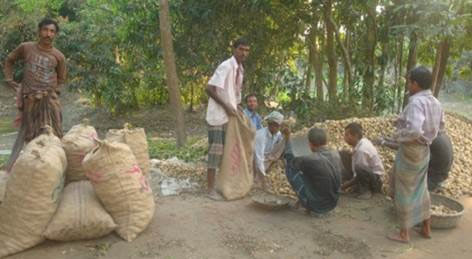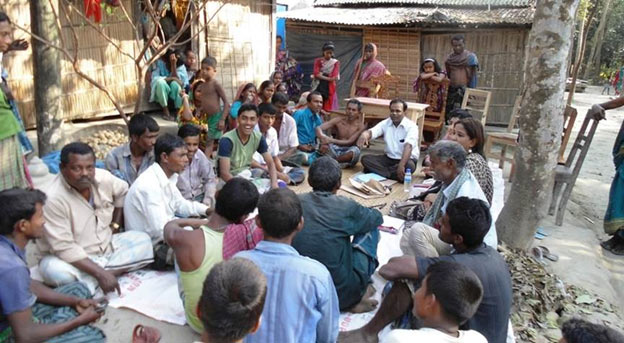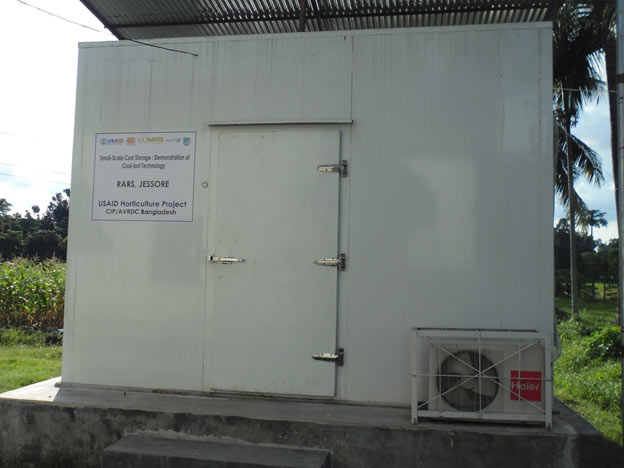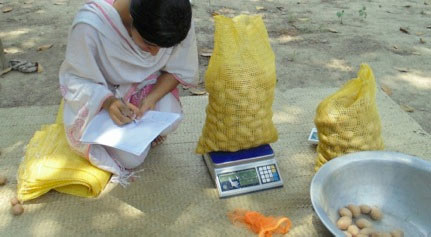Potato storage can be a challenge in a country like Bangladesh. The USAID Horticulture Project with CIP and AVRDC is working with communities to find the best options.
Once you harvest potatoes and sweetpotatoes – and this is especially important in tropical climates – you need to make sure they are stored in adequate spots where they can withstand heat, humidity, pests, and rodents. Storage is an important component of the Bangladesh Horticulture project; a USAID-funded project led by CIP and the World Vegetable Center (AVRDC) that aims to improve the nutritional security and incomes of 100,000 poor households in Southern Bangladesh through the exploitation of the full potential of potato, sweetpotato, and targeted crops such as tomato and okra.
In close cooperation with smallholder farmers and consumers, and with BRAC, PROSHIKA and the Bangladesh Agricultural Research Institute (BARI) as implementing partners, the four-year project introduces organizational and technological innovations to smallholder farmers, including best-bet technologies, and capacity strengthening. Innovative storage practices are an important component of helping smallholder farmers’ households to increase their food security through access to effective, low-cost ware (“table”) and seed storage.
“Northern Bangladesh is known as the potato-growing region, where commercial cold storage facilities can be found,” explained Tanvir Ahmed, a Project Coordinator with BRAC’s Agriculture and Food Security Programme. “However the Horticulture Project is working in Southern Bangladesh, where cold storages are hard to find, particularly in Barisal and Patuakhali.” Potato farmers in that region could not store their produced seed potatoes for planting in next season. So, every year they have collect new seed tubers with higher price.

Potato harvest in southern Bangladesh
Another problem with cold storage is that it is expensive. Farmers needing to store their potatoes for three to four months are usually required to pay rent for a full year. Finding cheaper alternatives to benefit these farmers was therefore necessary and the Project set out to find the most cost effective alternatives for greatest benefit.
In the districts of Jessore and Barisal – BRAC-operating areas – two different models of storage were piloted, including a small type potato storage with traditional materials available locally (11 storages were built for the cost of US$650 each) and a “CoolBot” type potato storage designed for potato seed only.
An important aspect of the project was the emphasis put on extensive dialogue and consultation, not only with the households willing to participate, but also with the community members involved in potato cultivation.
For the construction of the small “Ambient Type Potato Storage” in the designated areas, the Project used local materials such as bamboo, straw, and locally-made concrete – a construction project carried out by local carpenters. In order to help farmers adopt storage practices and include them within the Project, BRAC conducted community meetings to help designate the beneficiary families and teach them how to manage the potato storage units once built. These families share individual storage units, with five to nine families sharing a storage hut. So far, 44 families are participating in this innovative project, and success is growing in the involved districts. The ambient type stores are used to store 6-8 Tons of table potato for 3-4 months and farmers can get an increase (about 50%) in price of potato compared to the price during harvest.

Meeting with Community/potato farmers for facilitating community institution buidling
High temperatures are still a problem though, and the stored potatoes suffer from shriveling and sprouting. In many cases, temperature and humidity measurements taken inside and outside ambient stores and farmers’ homes showed no substantial difference between the stores and the farmers’ homes.
The Horticulture Project aims to build 12 CoolBot storage units, all power-generated with individual capacities of seven to eight tons, to assist farmers with seed potato storage in different project areas. During the first phase of the storage construction with the coolbot technology, based on the experiment conducted by the University of California-Davis (UC-Davis), the Project identified a few challenges. These included budgetary constraints and internal management – including the purchase, construction, transportation and assembly of the pre-fabricated Cool Store modules – and the lack of electricity. The next steps will include making all current CoolBot stores functional, install generators at all sites, and construct a few CoolBot stores with locally available material. The Project will also conduct experiments with other horticultural crops and carry out a complete economic analysis of various stores.
Photographs of Ambient Storage unit:

Potato stored inside the ambient store

Photographs of coolbot controlled storage unit (Coolbot storage)

Inside the cool room

USAID Visitors – team led by Ms. Ramona El Hamzaoui, Director – Economic Growth Office, USAID – Bangladesh in front of the Coolbot Storage

Potato stored inside the cool room

Setting Experiment
